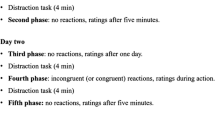Abstract
We studied if emotional empathy is related to sensitivity to facial feedback. The participants, 112 students, rated themselves on the questionnaire measure of emotional empathy (QMEE) and were divided into one high and one low empathic group. Facial expressions were manipulated to produce a happy or a sulky expression. During the manipulation, participants rated humorous films with respect to funniness. These ratings were the dependent variable. No main effect of facial expression was found. However, a significant interaction between empathy and condition indicated that the high as compared to the low empathic group rated the films as being funnier in a happy condition and a tendency to be less funny in a sulky condition. On the basis of the present results we suggest emotional empathy to be one important and previously ignored factor to explain individual differences in effects of facial feedback.


Similar content being viewed by others
References
Adelmann, P. K., & Zajonc, R. B. (1989). Facial efference and experience of emotion. Annual Review of Psychology, 40, 249–280.
Buck, R. (1980). Nonverbal behaviour and the theory of emotion: The facial feedback hypothesis. Journal of Personality and Social Psychology, 38, 811–824.
Buck, R. (1984). The communication of emotion. New York: Guilford Press.
Chlopan, B. E., McCain, M. L., Carbonell, J. L., & Hagen, R. L. (1985). Empathy: Review of available measures. Journal of Personality and Social Psychology, 48, 635–653.
Cohen, J. (1988). Statistical power analysis for the behavioural sciences (2nd ed.). Hillsdale: Erlbaum.
Cornelius, R. R. (1996). The science of emotion: Research and tradition in the psychology of emotion. Upper Saddle River, NJ: Prentice Hall.
Darwin, C. (1872). The expression of emotion in man and animals. London: Murray.
Davis, M. H. (1996). Empathy. A social psychological approach. Boulder: Westview Press.
Dimberg, U. (1982). Facial reactions to facial expressions. Psychophysiology, 19, 643–647.
Dimberg, U. (1988). Facial electromyography and the experience of emotion. Journal of Psychophysiology, 3, 277–282.
Dimberg, U. (1990). Facial electromyography and emotional reaction. Psychophysiology, 27, 481–494.
Dimberg, U. (1997). Facial EMG: Indicator of rapid emotional reactions [Abstract]. International Journal of Psychophysiology, 25, 52–53.
Dimberg, U., & Söderkvist, S. (2007). Unpublished manuscript.
Dimberg, U., Andréasson, P., & Thunberg, M. (2005). Empathy and facial reactions to facial expressions. Psychophysiology, 42, S50.
Dimberg, U., Thunberg, M., & Elmehed, K. (2000). Unconscious facial reactions to emotional facial expressions. Psychological Science, 11, 86–89.
Ekman, P. (1973). Cross-cultural studies of facial expressions. In P. Ekman (Ed.), Darwin and facial expression (pp. 169–220). New York: Academic Press.
Flack, W. F. (2006). Peripheral feedback effects of facial expressions, bodily postures, and vocal expressions on emotional feelings. Cognition and Emotion, 20, 177–195.
Hess, U., & Blairy, S. (2001). Facial mimicry and emotional contagion to dynamic emotional facial expressions and their influence on decoding accuracy. International Journal of Psychophysiology, 40, 129–141.
Hsee, C. K., Hatfield, E., Carlson, J. G., & Chemtob, C. (1990). The effect of power on susceptibility to emotional contagion. Cognition and Emotion, 4, 327–340.
Izard, C. E. (1977). Human emotions. New York: Plenum.
Laird, J. D. (1974). Self-attribution of emotion: The effects of expressive behaviour on the quality of emotional experience. Journal of Personality and Social Psychology, 29, 475–486.
Laird, J. D. (1984). The role of facial response in the experience of emotion: A reply to Tourangeau and Ellsworth, and others. Journal of Personality and Social Psychology, 47, 909–917.
Leslie, K. R., Johnson-Frey, S. H., & Grafton, S. T. (2004). Functional imaging of face and hand imitation: Towards a motor theory of empathy. NeuroImage, 21, 601–607.
Levenson, R. B., & Ruef, A. M. (1992). Empathy: A physiological substrate. Journal of Personality and Social Psychology, 63, 234–246.
Lundqvist, L., & Dimberg, U. (1995). Facial expressions are contagious. Journal of Psychophysiology, 9, 203–211.
MacDonald, A. (2003). I feel your pain (and joy): New theories about empathy. Brain Work, 13(4), 1–3.
Matsumoto, D. (1987). The role of facial response in the experience of emotion: More methodological problems and a meta-analysis. Journal of Personality and Social Psychology, 52, 769–774.
McIntosh, D. N. (1996). Facial feedback hypothesis: Evidence, implications, and directions. Motivation and Emotion, 20, 121–147.
Mehrabian, A., & Epstein, N. (1972). A measure of emotional empathy. Journal of Personality, 40, 525–543.
Schwartz, G. E., Fair, P. L., Salt, P., Mandel, M. R., & Klerman, G. L. (1976). Facial muscle patterning to affective imagery in depressed and nondepressed subjects. Science, 192, 489–491.
Sonnby-Borgström, M. (2002). Automatic mimicry reactions as related to differences in emotional empathy. Scandinavian Journal of Psychology, 43, 433–443.
Soussignan, R. (2002). Duchenne smile, emotional experience, and autonomic reactivity: A test of the facial feedback hypothesis. Emotion, 2, 52–74.
Strack, F., Martin, L. L., & Stepper, S. (1988). Inhibiting and facilitating conditions of the human smile: A nonobtrusive test of the facial feedback hypothesis. Journal of Personality and Social Psychology, 54, 768–777.
Tomkins, S. S. (1962). Affect, imagery, consciousness. New York: Springer.
Acknowledgements
This study was supported by grants to Ulf Dimberg from The Swedish Research Council and The Bank of Sweden Tercentenary Foundation. We thank Sven Söderkvist for his constructive contribution in the development of the specific method used in this study.
Author information
Authors and Affiliations
Corresponding author
Rights and permissions
About this article
Cite this article
Andréasson, P., Dimberg, U. Emotional Empathy and Facial Feedback. J Nonverbal Behav 32, 215–224 (2008). https://doi.org/10.1007/s10919-008-0052-z
Received:
Accepted:
Published:
Issue Date:
DOI: https://doi.org/10.1007/s10919-008-0052-z




